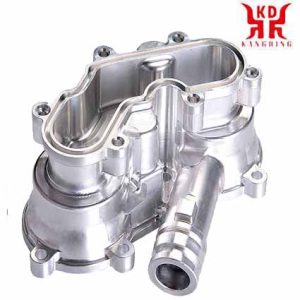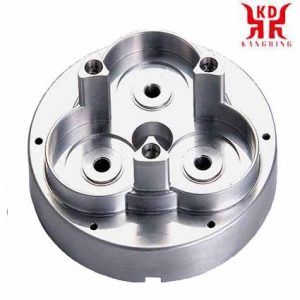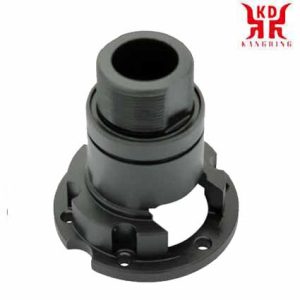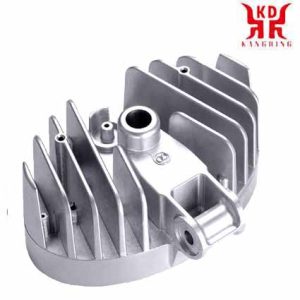Bu yazıda işleme süreçlerini tartışacağız (dönüm, frezeleme, Bitiricilik), aletler, Alüminyum ve alüminyum alaşımlarının CNC ile işlenmesindeki parametreler ve zorluklar. Ayrıca CNC işlemede en yaygın olarak kullanılan alüminyum ve alaşımların özelliklerini de analiz ediyoruz., ve çeşitli endüstriyel sektörlerdeki uygulama alanları.

Alüminyum alaşımlı parçaların hızlı prototiplenmesi
CNC işleme alüminyum ile ilgileniyorsanız, parçalarınız için buradan fiyat teklifi isteyebilirsiniz.
Alüminyum günümüzde en çok kullanılan malzemelerden biridir. Aslında, CNC işlemede kullanım sıklığı açısından alüminyum yalnızca çeliğin önüne geçmektedir. Bunun başlıca nedeni alüminyumun mükemmel işlenebilirliğidir..
Saf haliyle, alüminyum kimyasal elementi yumuşaktır, biçimlendirilebilir, manyetik değildir ve gümüşi beyaz bir görünüme sahiptir. Fakat, alüminyum elementi sadece saf haliyle kullanılmaz. Alüminyum normalde manganez gibi çeşitli elementlerle birlikte kullanılır., çeşitli özelliklerde yüzlerce alüminyum alaşımı üretmek için bakır ve magnezyum, önemli ölçüde geliştirilmiş özellikler. En yaygın alüminyum alaşımları ve bunların çeşitli standartlardaki ilgili tanımları burada bulunabilir.
Figür 1: Saf alüminyum
CNC ile işlenmiş bileşenler için alüminyum kullanmanın faydaları
Farklı özelliklere sahip birçok farklı alüminyum alaşımı olmasına rağmen, tüm alüminyum alaşımları aynı temel özelliklere sahiptir.
İşlenebilirlik
Alüminyum çeşitli farklı yöntemler kullanılarak şekillendirilebilir ve işlenebilir. Yumuşak ve işlenebilirliği yüksek olduğundan işleme makinaları yardımıyla hızlı ve kolay bir şekilde kesilebilir.. Ayrıca çelikten daha ucuzdur ve daha az işleme gerektirir. Bu özellikler kesme makinesi operatörüne ve müşteriye büyük fayda sağlar. Ek olarak, Alüminyum, yüksek işlenebilirliği nedeniyle işleme sırasında daha az deforme olur. Bu daha yüksek doğruluk sağlar, CNC makineleri daha yüksek toleranslara ulaşabildiğinden.
Güç/ağırlık oranı
Alüminyumun yoğunluğu çeliğin yoğunluğunun yaklaşık üçte biri kadardır. So aluminum is relatively light. Despite its low weight, aluminum is very strong. This combination of high strength and low weight is described by the strength-to-weight ratio. Its high strength-to-weight ratio makes aluminum an advantageous material for components in various industrial sectors, such as the automotive and aerospace industries.
Corrosion resistance
Aluminum is scratch and corrosion resistant under typical marine and atmospheric conditions. These properties can be enhanced by anodizing. It should be noted, Yine de, that corrosion resistance varies with the type of aluminum. Fakat, the most common types of aluminum used in CNC machining have the highest resistance.
Behavior at low temperatures
Most materials tend to lose some of their beneficial properties at temperatures below zero. Örneğin, both carbon steel and rubber become brittle at low temperatures. In contrast, aluminum remains soft, malleable and strong even at very low temperatures.
Electric conductivity
The electrical conductivity of pure aluminum at room temperature is 36.7 million Siemens per meter. Although aluminum alloys can have lower conductivities than pure aluminum, they are conductive enough to be used as electrical components. Diğer taraftan, aluminum is unsuitable if a high electrical conductivity of the manufactured component is undesirable.
Recyclability
Since CNC machining is a subtractive manufacturing process, a lot of chips and therefore a lot of material waste occur during machining. Aluminum is well suited for recycling, yani. relatively little energy, effort and costs are required to recycle aluminum. This also makes it an advantageous material in terms of avoiding waste of material. This also makes aluminum a more environmentally friendly material in CNC machining.
Anodizing
The anodizing process is a surface finishing process that improves the wear resistance and corrosion resistance of a material. Aluminum is suitable for the anodizing process. This process also makes it easier to color the manufactured aluminum components.

Alüminyum parçaların CNC frezelenmesi
Popular aluminum alloys for CNC machining
In our experience, the following 5 types of aluminum are most commonly used in CNC machining.
EN AW 2007
Alternative names: 3.1645; EN 573-3; AlCu4PbMgMn.
This aluminum alloy contains copper as the main alloying element (4-5% bakır). It is a short-chip alloy that is light, durable, highly functional and has the same mechanical properties as AW 2030. It is also suitable for thread cutting, ısıl işlem ve yüksek hızda işleme. Tüm bu özellikler EN AW'yi yapar 2007 bileşenlerin üretiminde yaygın olarak kullanılan bir malzeme, cıvatalar, vidalar, Fındık, perçinler ve dişli çubuklar. Fakat, bu tip alüminyumun kaynaklanabilirliği ve korozyon direnci zayıftır; Bu nedenle bileşen üretildikten sonra koruyucu eloksal kullanılması tavsiye edilir..
EN AW 5083
Alternative names: 3.3547; Alaşım 5083; EN 573-3; ABD A95083; ASTM B209; AlMg4.5Mn0.7
AW 5083 zorlu koşullarda mükemmel performansıyla tanınır. Magnezyum ve eser miktarda krom ve manganez içerir.. Bu çeşit, kimyasal ve deniz ortamlarında korozyona karşı çok yüksek bir dirence sahiptir.. AW 5080 Isıl işlem görmeyen tüm alaşımlar arasında en yüksek dayanıma sahiptir; kaynak sonrasında bile aldığı bir özellik. Bu alaşım, sıcaklığın üzerindeki uygulamalarda kullanılmamalıdır. 65 ° C, düşük sıcaklık uygulamalarında mükemmel performansa sahiptir.
Because of its range of beneficial properties, AW 5080 is used for a wide variety of applications including cryogenic systems, marine applications, pressure systems, chemical applications, welded structures and vehicle bodies.

Surface finishing of aluminum alloy parts
EN AW 5754
Alternative names: 3.3535; Alaşım 5754; EN 573-3; U21NS A95754; ASTM B 209; Al-Mg3.
As an aluminum-magnesium kneading material with the highest percentage of aluminum, AW 5754 can be rolled, forged and extruded. It is not heat treatable and can be cold worked to increase strength at the expense of formability. Ek olarak, this alloy is excellent in corrosion resistance and has high strength. With these properties, it is not surprising that AW 5754 is one of the most widely used types of aluminum in CNC machining. It is commonly used in welded structures, floors, fishing gear, vehicle bodies, rivets, and in food processing.
EN AW 6061
Alternative names: 3.3206; ISO 6361; UNS A96060; ASTM B 221; AlMgSi0.5
Bu magnezyum ve silikon içeren işlenmiş bir alaşımdır. Isıl işlem görebilir ve ortalama mukavemete sahiptir, iyi kaynaklanabilirlik ve iyi şekillendirilebilirlik. Ek olarak, çok yüksek korozyon direncine sahiptir; eloksallama ile geliştirilebilecek bir özellik. EN AW 6060 inşaatlarda yaygın olarak kullanılmaktadır, Gıda işleme, tıbbi teknoloji ve otomotiv teknolojisi.
EN AW 7075
Alternative names: 3.4365; UNS A96082; H30; Al-Zn6MgCu.
Bu tip alüminyumun ana alaşım elementi çinkodur.. TR AW olmasına rağmen 7075 ortalama işlenebilirliğe sahiptir, zayıf soğuk şekillendirme özellikleri ve kaynak veya lehimleme için uygun değildir, yüksek bir mukavemet-ağırlık oranına sahiptir, atmosferik ve deniz ortamlarına karşı mükemmel direnç, ve bazı çelik alaşımlarıyla karşılaştırılabilir dayanıklılık. Bu alaşım çok geniş bir uygulama alanında kullanılmaktadır. – planörlerden, bisiklet çerçeveleri, imalat araçlarının yapımına tırmanma ekipmanı ve silahları.

Turned parts of aluminum alloy
CNC machining process for aluminum
Aluminum can be machined using many of the CNC processes available today. We have listed some of these procedures:
Tornalama
In CNC machining processes, the workpiece rotates while the single-point cutting tool remains stationary along its axis. Depending on the machine used, either the workpiece or the cutting tool performs a feed movement in order to remove the material.
Find out more about our CNC turning services.
Frezeleme
Milling processes are the most frequently used methods when machining aluminum components. These methods consist of rotating a multipoint cutting tool along its axis while the workpiece remains stationary along its own axis. Kesme eylemi ve ardından gelen talaş kaldırma işlemi, iş parçasının veya kesme takımının ilerleme hareketi ile gerçekleştirilir., veya her ikisinin bir kombinasyonu. Bu hareket birkaç eksende gerçekleşebilir.
CNC frezeleme hizmetlerimiz hakkında daha fazla bilgi edinin.
Cep frezeleme
Cep frezeleme, cebe sokma olarak da bilinir, içi boş bir cebin bir bileşen halinde frezelendiği bir CNC frezeleme yöntemidir.

Alüminyum alaşımlı parçaların CNC ile işlenmesi
Yüzey tornalama ve yüzey frezeleme
Makine işlemede, karşı karşıya / Frezeleme, iş parçasının yüzeyinde tornalama yoluyla düz bir kesit alanı oluşturulmasıdır. / frezeleme.
Sondaj
Delme, iş parçasında delik oluşturma işlemidir. bu süreçte, belirli bir boyutta çok noktalı dönen bir kesici takım düz bir çizgide hareket eder, işlenecek yüzeye dik, etkili bir şekilde bir delik oluşturmak.
Tools for aluminum processing
Many different factors play a role when selecting tools for CNC machining.
Tool design
Different geometry aspects of a tool contribute to the effectiveness in terms of aluminum machining. One of them is the number of cutting edges. In order to avoid difficulties in removing chips at high speeds, the cutting tools for aluminum CNC machining should have 2-3 cutting edges. A higher number of cutting edges leads to smaller chip bays. This causes the large chips of the aluminum alloys to get stuck. When cutting forces are low and chip evacuation is a major concern of the process, two cutting edges should be used. Three cutting edges can be used for the perfect balance between chip evacuation and tool strength.
Helix angle
Helis açısı, bir takımın merkez çizgisi ile kesme kenarı boyunca uzanan düz bir teğet çizgi arasındaki açıdır.. Yüksek helis açısı talaşları hızla temizlerken, bu aynı zamanda işleme sırasında sürtünmeyi ve ısı oluşumunu da artırır. Bu, alüminyumun yüksek hızlı CNC işlenmesi sırasında talaşların takım yüzeyine kaynaklanmasına neden olabilir. Daha küçük bir sarmal açısı daha az ısı üretimine neden olur, ancak talaşları etkili bir şekilde çıkaramayabilir. Alüminyum işlerken, bir eğim açısı 35 ° veya 40 ° kaba uygulamalara uygundur, bir açı iken 45 ° bitirme işi için uygundur.
Açıklık açısı
Boşluk açısı, bir aletin düzgün çalışması için bir diğer önemli faktördür. Aşırı büyük bir açı, aletin parçaya girmesine ve ileri geri sallanmasına neden olur. Diğer taraftan, angles that are too small can lead to high friction between the tool and the workpiece. Clearance angles between 6 ° and 10 ° are particularly suitable for CNC machining of aluminum.

Aluminum die casting
Tool material
Tungsten carbide is the preferred material for cutting tools used in CNC aluminum machining. Since aluminum is very soft and easy to cut, the decisive factor in a cutting tool for aluminum is not the hardness, but the ability to obtain a razor-sharp edge. This ability is present in cemented carbide tools and depends on two factors, the cemented carbide grain size and the proportion of binder. While a larger grain size results in a harder material, a smaller grain size guarantees a tougher, more impact-resistant material that is exactly the property we need. Daha küçük taneler, malzemenin ince taneli yapısını ve gücünü elde etmek için kobalt gerektirir.
Fakat, Kobalt, yüksek sıcaklıklarda alüminyumla reaksiyona girer ve takım yüzeyinde alüminyumdan yapılmış bir kenar oluşturur.. Önemli olan doğru miktarda kobalt içeren semente karbür takım kullanmaktır (2-20%) Gerekli gücü korurken bu reaksiyonu en aza indirmek için. Tungsten karbür takımlar genellikle CNC alüminyum işlemenin yüksek hızlarına dayanma konusunda çelik takımlara göre daha uygundur. Alet malzemesine ek olarak, Aletin kaplaması, aletin kesme verimliliğinde önemli bir faktördür.
ZrN (zirkonyum nitrür), TiB2 (titanyum borür) ve elmas benzeri kaplamalar, alüminyumun CNC ile işlenmesi için uygun takım kaplamalarından bazılarıdır..
Beslemeler ve hızlar
Kesme hızı kesici takımın dönme hızıdır. Alüminyum çok yüksek kesme hızlarına dayanabildiğinden, alüminyum alaşımları için kesme hızı, kullanılan makinenin uygulama sınırlarına bağlıdır. CNC alüminyum işlemede olduğu gibi, Hız mümkün olduğu kadar yüksek olmalı, bu, kenarlarda yığılma riskini azalttığı için, zaman kazandırır, bileşendeki sıcaklık artışını en aza indirir, talaş kırılmasını iyileştirir ve yüzey kalitesini iyileştirir. Tam çalışma hızı alüminyum alaşımına ve takım çapına bağlıdır.
İlerleme, iş parçasının veya aletin aletin devri başına hareket ettirildiği mesafedir. Kullanılan ilerleme hızı istenen yüzey kalitesine bağlıdır, iş parçasının gücü ve sertliği. Kaba kesimler besleme gerektirir 0.15 ile 2.03 mm / devir, bitirme işlemleri besleme gerektirirken 0.05 ile 0.15 mm / devir.
Soğutma yağı
Despite its good machinability, aluminum should never be cut dry as this promotes the formation of built-up edges. Suitable cooling lubricants for aluminum CNC machining are soluble oil emulsions and mineral oils. Avoid cooling lubricants that contain chlorine or active sulfur, as these elements pickle aluminum. You can find out more about cooling lubricants here.

CNC machining aluminum alloy cavity
Post-processing processes
After machining an aluminum part, there are certain processes that can be carried out to improve the physical, mechanical and aesthetic properties of the part. The most common methods are listed below.
Pearl blasting – compressed air blasting with solid abrasive
Bead blasting is a finishing process for aesthetic purposes. bu süreçte, the manufactured component is blasted with a strong jet of compressed air and tiny glass beads, which effectively removes the material and ensures a smooth surface. It gives aluminum a satin or matt surface. The most important process parameters for bead blasting are the size of the glass beads and the strength of the air pressure used. Use this procedure only when the dimensional tolerances of the part are not critical.
Other finishing processes are polishing and painting.
Coating
bu süreçte, the aluminum workpiece is coated with another material, for example zinc, nickel or chromium. This is done to improve the functionality of the component and can be achieved through electrochemical processes.
Anodizing
The anodizing process is an electrochemical process in which the aluminum workpiece is placed in a solution of sulfuric acid. An electrical voltage is then applied between the anode and cathode. This process converts the exposed surfaces of the workpiece into an electrically non-reactive aluminum oxide coating. The density and thickness of the coating depends on the composition of the solution, the duration of the anodizing process and the electrical current applied. Anodizing can also be used to color the component.

Aluminum profile
Powder coating
In the powder coating process, the component is coated with a colored polymer powder using an electrostatic spray gun. The part is then cured at a temperature of 200 ° C. The powder coating improves strength and resistance to wear, corrosion and impact.
Isı tedavisi
Components made from heat-treatable aluminum alloys can be subjected to a heat treatment to improve their mechanical properties.
Applications of CNC-manufactured aluminum components in industry
As mentioned above, aluminum alloys have a number of advantageous properties. This is why CNC-manufactured aluminum components are indispensable in many branches of industry, including:
Aerospace: Due to the high strength-to-weight ratio, many aircraft fittings are made of aluminum.
Automotive industry: similar to the aerospace industry, many components such as axles and other components are made of aluminum.
Electronics: Due to their high electrical conductivity, CNC-manufactured aluminum components are often used as electrical components in electrical devices.
Food and pharmaceutical industry: Since aluminum does not react with most organic substances, aluminum components play an important role in the food and pharmaceutical industries.
Sports: Aluminum is widely used to make sports equipment such as baseball bats and whistles.
Low-temperature technology: Due to the ability of aluminum to maintain its mechanical properties even at temperatures below zero, aluminum components are often used in low-temperature applications.
 English
English العربية
العربية 中文(漢字)
中文(漢字) Čeština
Čeština Dansk
Dansk Nederlands
Nederlands Suomi
Suomi Français
Français Deutsch
Deutsch Italiano
Italiano 日本語
日本語 ಕನ್ನಡ
ಕನ್ನಡ 한국어
한국어 Português
Português Русский
Русский Slovenčina
Slovenčina Español
Español Svenska
Svenska Türkçe
Türkçe

